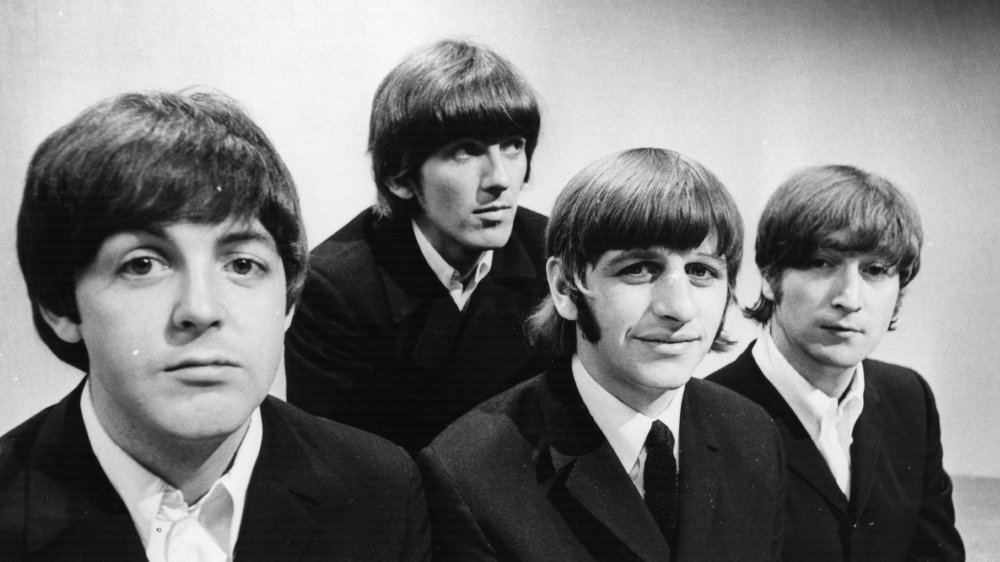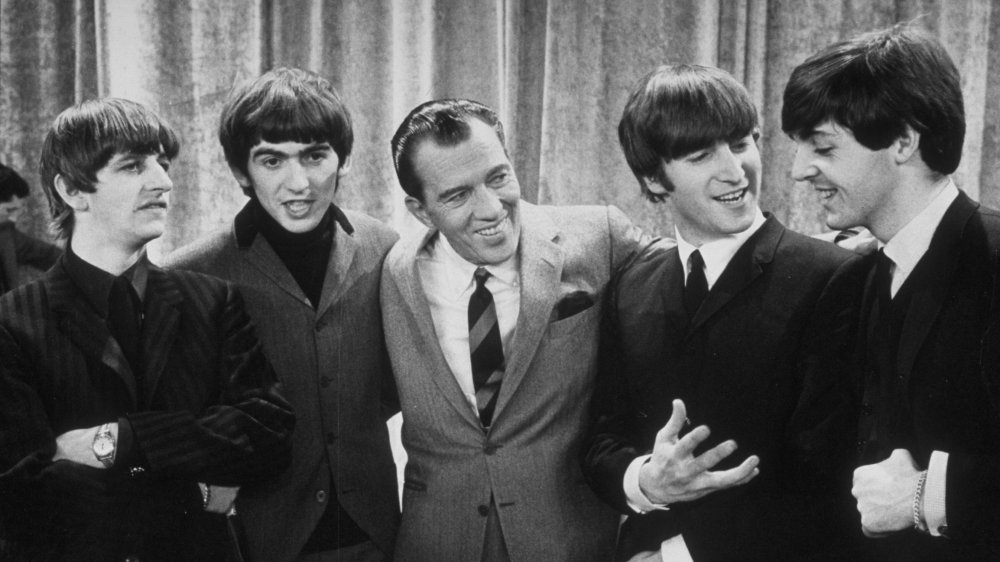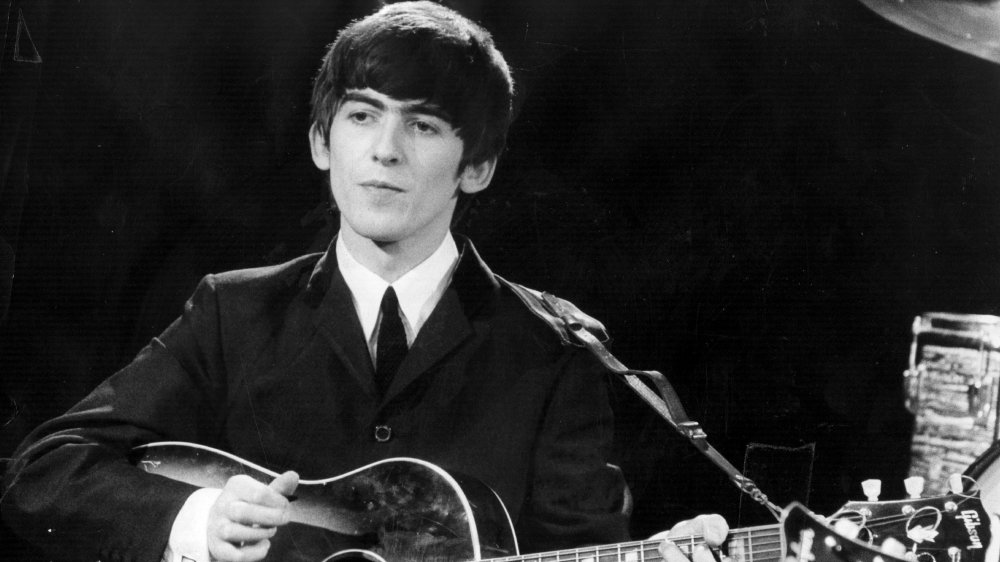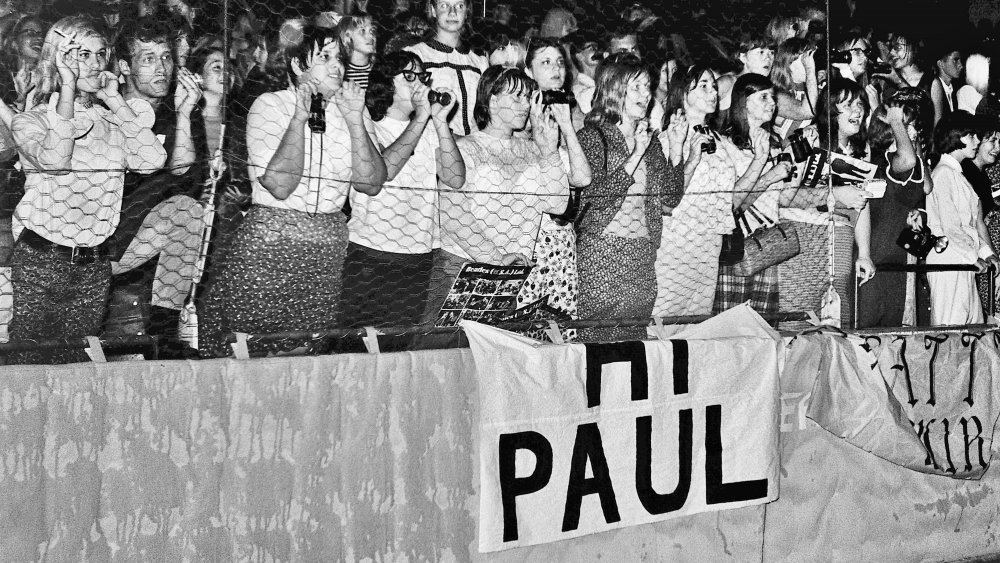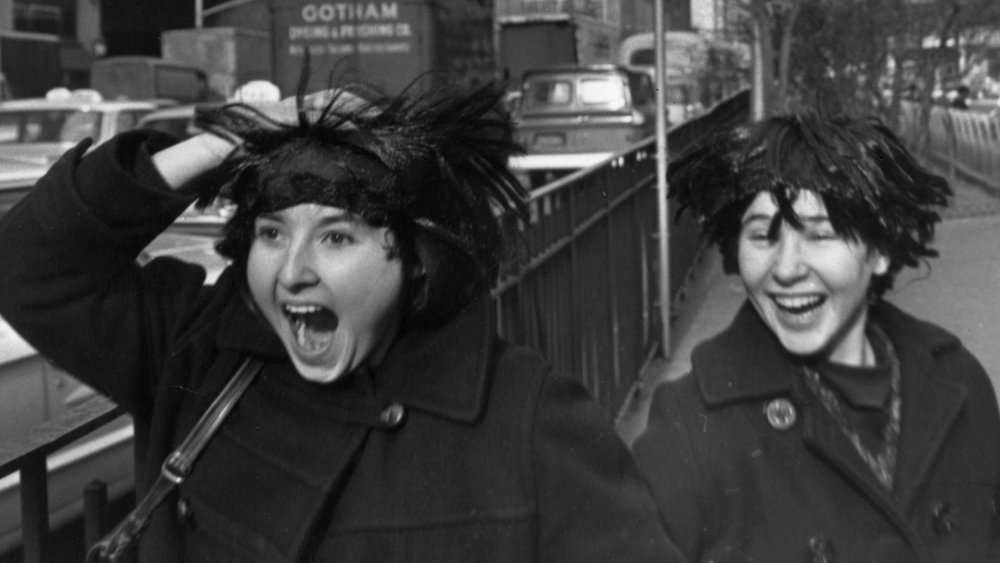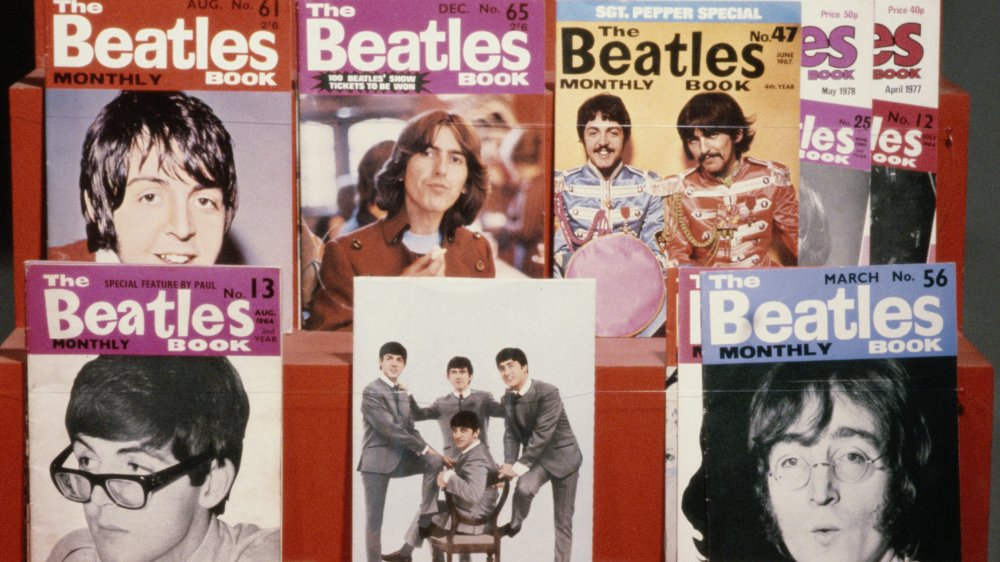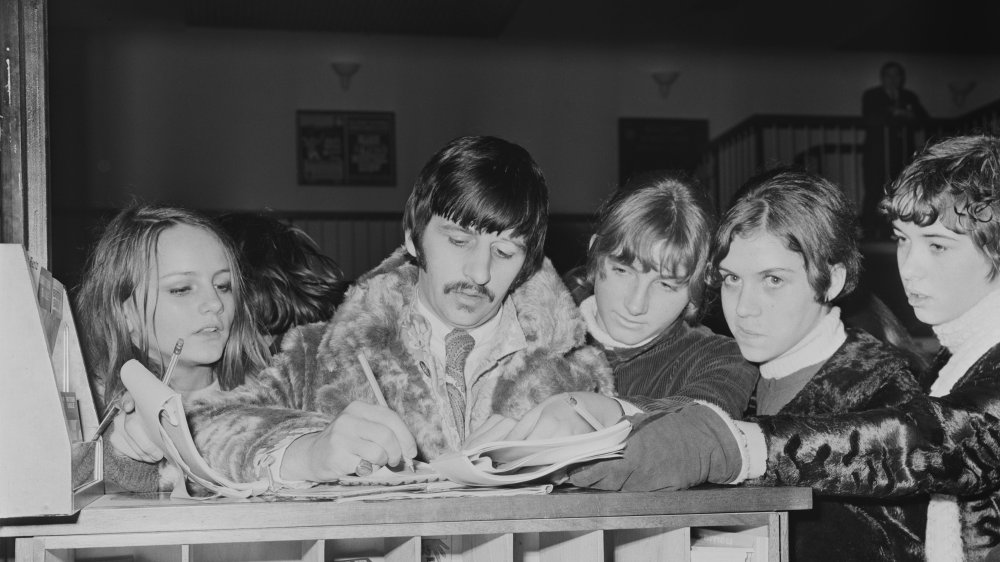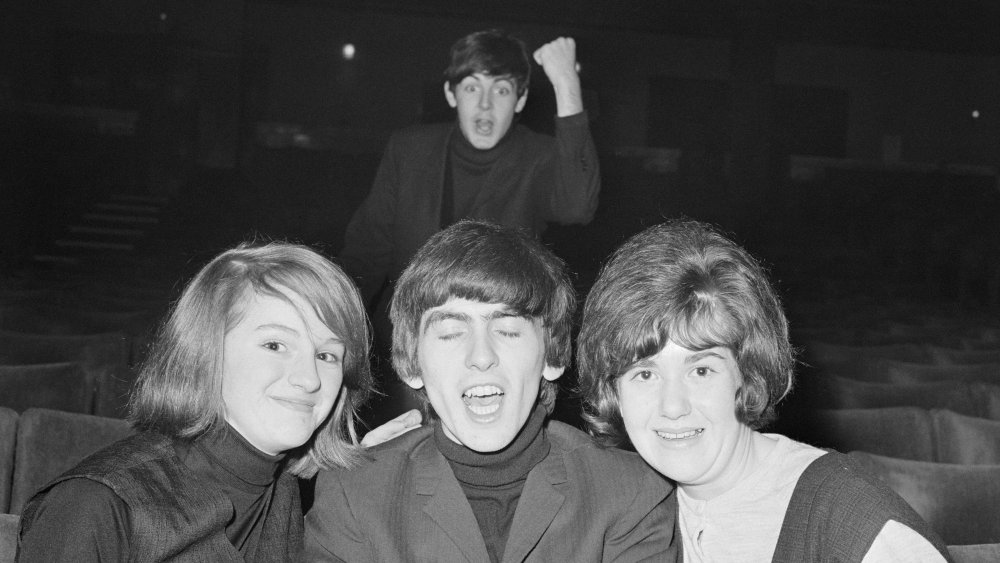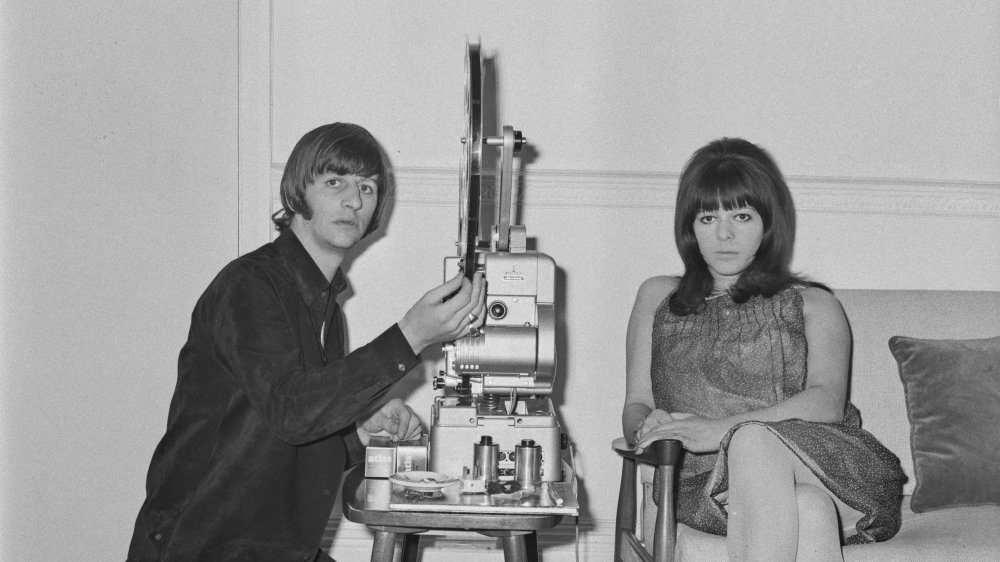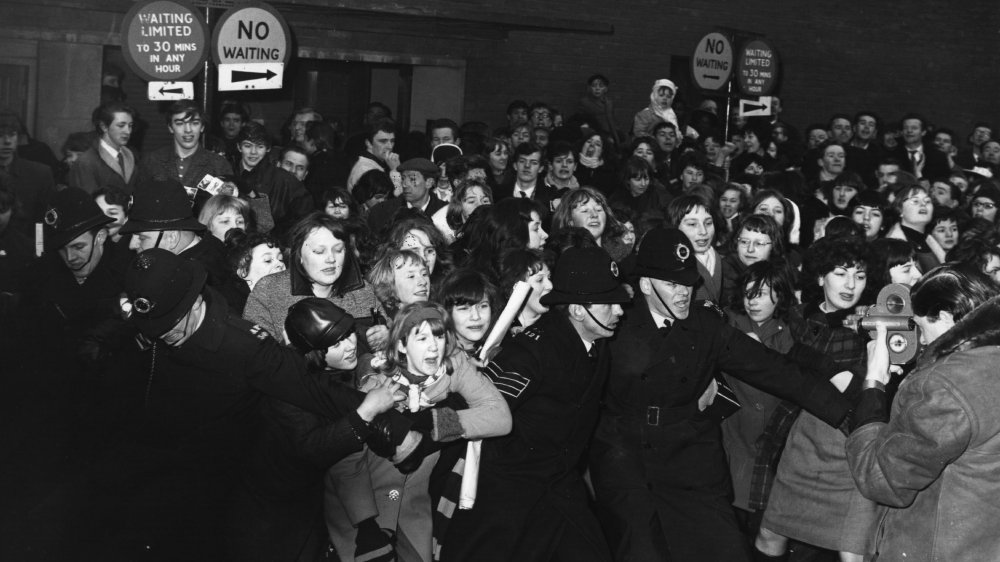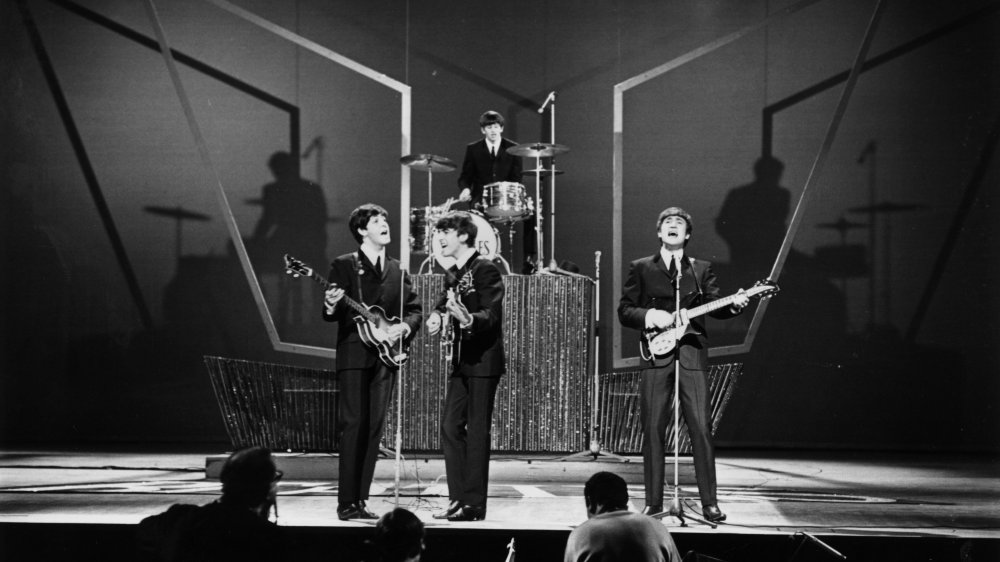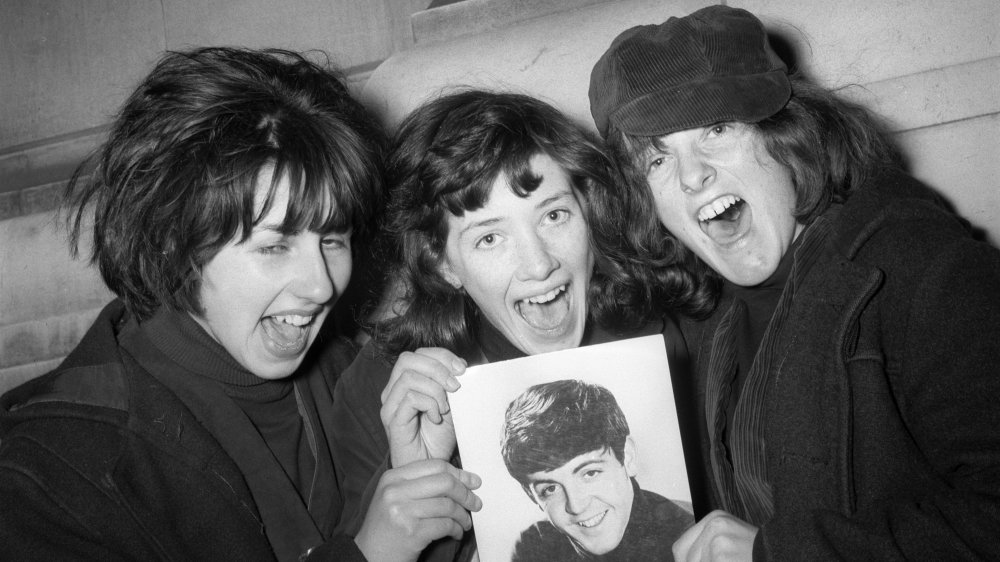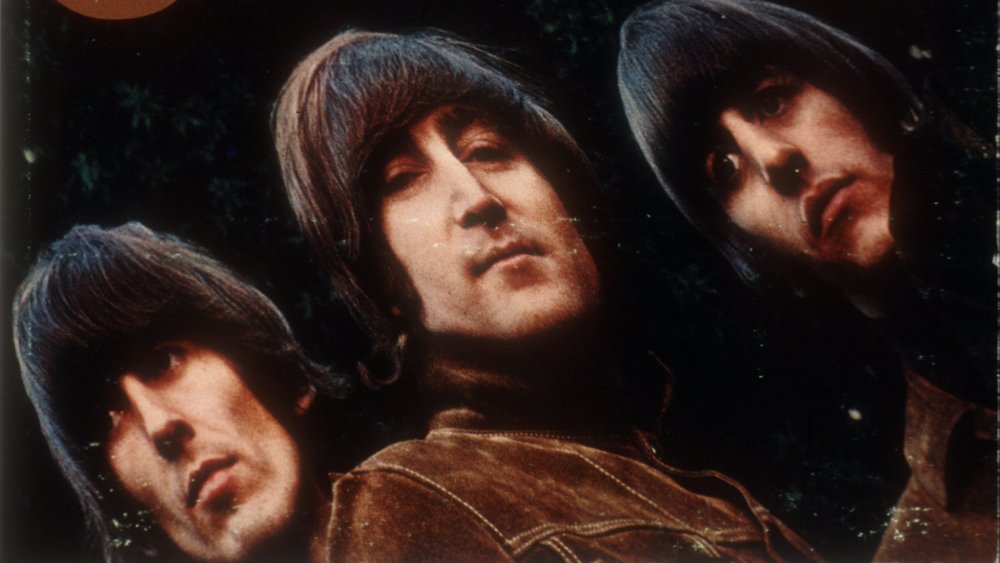What It Was Really Like To Be A Beatles Fan In The 1960s
The Beatles were one of the greatest rock 'n' roll bands of all time. They also had one of the fiercest, most intensely loyal fandoms of all time. Beatles fans — mainly teenage girls — offered the band their unbridled devotion throughout the 1960s, buying records and gathering at concert venues in a way that the world had never witnessed before. Without their help, the Fab Four would have never become the legends they are today.
Being a Beatles fan was a wild ride. It meant watching the band's performances on The Ed Sullivan Show, reading The Beatles Book religiously, attending sold-out shows, and waiting at whichever airport the boys were flying into to welcome them with shouts of glee. It also meant weathering criticism from misogynistic journalists and far-right pastors who thought that mass hysteria and demonic influence were the only possible explanations for the band's popularity. Here's what it was really like to experience Beatlemania, in all its glory and chaos.
Watching the band's TV performances was a big deal
In the '60s — an era when television was still a modern marvel, and viewers only had a few channels to choose from — TV variety shows were one of the most important determinants of pop culture. Thus, Beatles fans were especially eager to show their support for their favorite boys by watching them on the small screen whenever they scored a televised gig. The band's February 9, 1964 performance on The Ed Sullivan Show was a particularly historic moment. According to the show's official website, it was their first live American television appearance — and this was a major deal, considering that the Beatles had quite the adoring audience in the States. The boys played five of their most popular songs at the time: "All My Loving," "Till There Was You," "She Loves You," "I Saw Her Standing There," and "I Want to Hold Your Hand." The performance drew 73 million people to their TV screens.
In honor of the iconic broadcast's 50th anniversary in 2014, the Los Angeles Times collected accounts from readers who remembered it fondly. One fan, a man named David Brisker, recalls watching the spectacle with his parents: "When the Beatles finished, without a word, my sister and I turned and faced one another, eyes wide and mouths open in shock ... We had just witnessed a seismic cultural shift." His father initially dismissed the Beatles as a "fad," but within a year, he, too, was praising their songwriting skills.
Concerts involved screaming, fainting, and Jelly Babies
Beatles concerts were places of exhilarating chaos. As the Week reports, they were typically rife with screaming, crying, and fainting. They also involved a stranger occurrence: the ritualistic pelting of the Beatles with a British candy called Jelly Babies.
According to the Guardian, Jelly Babies became associated with the Beatles in 1963, when George Harrison mentioned his fondness for them in an interview. Beatles fans pounced on this admission and began to send him Jelly Babies in the mail. Soon, they were also bringing them to shows and tossing them at the stage. The sweets were intended as tokens of affection. However, they greatly hindered the boys' ability to play. Eventually, George decided to make his true feelings on the matter known in a reply letter to a 15-year-old fan named Lynn Smith.
"Think how we feel standing on stage trying to dodge the stuff, before you throw some more at us. Couldn't you eat them yourself, besides it is dangerous," he wrote. "I was hit in the eye once ... and it's not funny!
Fan clubs were popular
In the 1960s, the Beatles' greatest devotees could demonstrate their loyalty by joining the band's Official Fan Club. The secretary of this organization was a Beatles fan herself: a young woman named Freda Kelly. According to the New York Post, Kelly got to know the Beatles by attending their early shows. When she was 17, their manager Brian Epstein offered her the secretary position. Despite her fervor for the Fab Four, Kelly stayed tight-lipped about her job. In fact, Ryan White, a longtime family friend who directed a 2013 documentary about Kelly called Good Ol' Freda, thought that Kelly was simply working for a law firm at the time.
Given her years as a face in the crowd at Beatles shows, Kelly understood fans' psyche in a special way and was often willing to entertain interesting requests for them. Once, a fan sent her a piece of gum in hopes that she would ask a Beatle to chew it — and she obliged. Another time, she had Ringo Starr sleep on a pillowcase so she could send it to a fan. She ran the club with her characteristic dedication and verve all the way until the Beatles' breakup.
Consequence of Sound reports that plenty of fans started their own unofficial clubs, as well. Many of them amassed private collections of Beatles memorabilia. One Oregon club possessed a whopping "30 Beatle books, 9 Beatle records, over 2,000 Beatle bubblegum cards (some are duplicates) and 3,000 Beatles pictures."
Beatles fans loved their merch
Beatles fans who wanted to show off their affinity for the band with merch had a vast array of products to choose from. According to Consequence of Sound, in 1964, the Wall Street Journal declared that Beatlemaniacs across America were buying "Beatle wigs, Beatle dolls, Beatle egg cups and Beatle T-shirts, sweatshirts and narrow-legged pants." Beatle wigs? That's right. Plenty of the band's biggest admirers saw them as the perfect accessory to sport at concerts. The pop-on mop-tops were so popular that Lowell Toy Company, their officially licensed manufacturer, once told a reporter, "We're turning out about 15,000 a day, but we've got a backlog of 500,000 orders."
The wigs were only the tip of the iceberg. According to American Profile, young Beatles lovers in the '60s could also purchase officially licensed Beatles Halloween costumes, complete with flame-retardant masks. Beatles-themed board games, stockings printed with the boys' faces, Beatles-branded hairspray, and "Big Beat Beatles Bongos" were available, as well.
The Beatles had their own magazine
The Beatles' most dedicated supporters got their info on the band from The Beatles Book, also known as Beatles Monthly. According to Ultimate Classic Rock, this official Beatles magazine was created by publisher Sean O'Mahony when he realized that the band's young, eager fandom was likely to stick around for some time. A whopping 77 issues were released from 1963 to 1969, each one containing "32 pages of features, lyrics, fan mail, contests, polls and — most importantly — pictures of the lovable moptops by photographer Leslie Bryce." O'Mahony also wrote a letter to go with every issue, using the pen name Johnny Dean.
The Beatles Book made a surprise comeback in 1976 when O'Mahony decided to reprint the original magazines with additional brand-new content. In 1982, he ran out of issues to bring back — but he didn't stop there. He continued to publish original commentary on the Beatles until 2003, when Beatles Monthly finally came to an end. The magazine had an impressive run, clocking in at 321 issues.
Fans went to extremes to catch glimpses of the Beatles in public
The most die-hard Beatles fans constantly kept tabs on the band's whereabouts so that they could try to spot them in person. As stated by Geoff Emerick in his book Here, There and Everywhere: My Life Recording the Music of the Beatles, when the Beatles recorded "She Loves You" at EMI Studios in 1963, dozens of fans gathered outside the studio. Some even broke through a police blockade in hopes of getting to the band.
This incident was only the beginning of the chaos that was to come. According to fan site Beatles Bible, when the Fab Four returned to England after a tour of Sweden in 1963, they were met with not hundreds, but thousands of fans at London's Heathrow Airport. They received similar treatment when they arrived in America for the first time in 1964. Marvin Scott, a reporter who was present when the band touched down at John F. Kennedy Airport on that fateful day, remembers the hubbub fondly in a 2014 article for the New York Daily News. "Fifty years later, I can hear [the fans'] screams ringing in my ears. They were electrifying," Scott says.
The Apple Scruffs were especially hardcore
The most intense Beatles admirers in the band's heyday were a group of youngsters known as the Apple Scruffs. These fans were known for waiting long hours outside the Apple Corps building (the headquarters of the Beatles' company) and Abbey Road Studios in hopes of crossing paths with the Fab Four. According to Rolling Stone, they were often in luck: interactions with the boys were not uncommon. In fact, it became a regular occurrence for Ringo Starr to joke, "Hello girls, busy day?" as he walked into the building.
From time to time, the Apple Scruffs took their admiration to extremes. On one occasion, a handful of Scruffs decided to visit the McCartneys' home. When they noticed that Paul wasn't there — and that one of the windows was open — they snuck inside and snatched some of his belongings. This hullabaloo inspired the 1969 Beatles song "She Came in Through the Bathroom Window."
Even amidst events like these, the Beatles were impressed by the dedication of the Apple Scruffs. In fact, George Harrison found them so endearing that he wrote them a song, aptly titled "Apple Scruffs," for his 1970 solo album All Things Must Pass. "You've been stood around for years/Seen my smiles and touched my tears/How it's been a long, long time/And how you've been on my mind, my Apple Scruffs," he sang on the tender ballad. "How I love you, how I love you."
Some fans went the extra step and became groupies — or girlfriends
Despite their early squeaky-clean image, the Beatles did hook up with a good number of female fans. According to GQ, in the 1970s, John Lennon criticized the press for routinely downplaying the band's wilder side, claiming that "The Beatles tours were like the Fellini film Satyricon." While Paul McCartney didn't describe the Beatles' tour activity in such colorful terms, he did admit to engaging in some antics. "There were sexual encounters of the celestial kind, and there were groupies," he said in 2018.
One of the luckiest Beatles fans was perhaps Maureen Cox, who became Ringo Starr's girlfriend after captivating him at shows. Pattie Boyd, who married George Harrison in the 1960s, shares Cox's story in her autobiography Wonderful Tonight. "She was a fan whose dream had come true," Boyd writes. "She had started out as one of the hundreds of teenage girls who queued day after day at the Cavern to get close to the front of the stage for the best possible view of the Beatles and in the hope that they might catch the eye of one. Every fan had a favorite, and Ringo was hers. She wouldn't have called herself a fanatic ... but she did run after Ringo in the street one day to get his autograph ... Then, one day, it happened for her." Cox and Starr were married in 1965; they split after ten years.
Beatles fans were often called hysterical
Due to their frenzied behavior at concerts, Beatles fans were often derided as crazy and irrational by critics, especially those who were male. An article called "The Menace of Beatlism," written by journalist Paul Johnson for The New Statesman in 1964, was particularly harsh. In the article, Johnson calls the Beatles' teenage fans "moronic" and dismisses their concerts as "a collective groveling to gods who are blind and empty." He ends his rant with a controversial assertion: "Those who flock round the Beatles, who scream themselves into hysteria, are the least fortunate of their generation, the dull, the idle, the failures."
In 1966, responding to the wave of ridicule aimed at Beatles fans, A.J. Taylor conducted a scientific study ("Beatlemania: A study in adolescent enthusiasm") to see if there were any key mental differences between Beatles fans and young people who were not particularly enamored with them. Young test subjects between the ages of 15 and 20 were split into three groups: those who were "highly enthusiastic" about the band, those who were only moderately enthusiastic, and those with low enthusiasm. The study found no difference in "hysteria" or "neuroticism" between the two groups and concluded that "'Beatlemania' is the passing reaction of predominantly young adolescent females to group pressures of such a kind that meet their special emotional needs," contradicting Johnson's harsh hypothesis.
Beatles fans were demonized by right-wing Christians
The Beatles were seen as sinful by certain American pastors, especially after John Lennon remarked that the Beatles were "more popular than Jesus" in a 1966 interview with the London Evening Standard (now preserved digitally by BeatlesInterviews.org). In an article for Popular Music, Mark Sullivan chronicles the extreme backlash that occurred after this remark. Multiple radio stations in the "Bible belt" scrapped the Beatles from their playlists and sponsored record burnings. One pastor, Reverend Thurman H. Babbs of the New Heaven Baptist Church in Cleveland, Ohio, even declared that any member of his congregation who saw the Beatles in concert would no longer be welcome at Sunday services.
Perhaps the most famous Christian dismissal of the Fab Four is the pamphlet "Communism, Hypnotism, and The Beatles," written by evangelical leader David Noebel in 1965 (now archived at Alpha History). Noebel believed that many of the most popular musicians of the day were part of a secret Soviet plot to brainwash American teenagers. He saw the Beatles as the worst of these evil rock forces.
Noebel was especially horrified by the frantic actions of Beatles fans at concerts. In his pamphlet, he demonizes them as signs of "teenage mental breakdown" and "juvenile delinquency." "Throw your Beatle ... records in the city dump. We have been unashamed of being labeled a Christian nation; let's make sure four mop-headed anti-Christ beatniks don't destroy our children's emotional and mental stability and ultimately destroy our nation," he wrote.
Beatles fandom was a rite of passage for many teenage girls
Traditionally-minded adults in the 1960s wanted to believe that teenage girls' reaction to the Beatles was due to "hysteria" or demonic influence. Yet the real explanation is far simpler: they were exploring what it meant to be young and female in the midst of a cultural revolution. Many girls joined the Beatles fandom because, in addition to enjoying the music, they saw it as a healthy way to explore their burgeoning sexual desires. Their behavior was also a revolt against the expectations set by American society, which pressured them to be proper and demure. The Washington Post reports that author Barbara Ehrenreich went so far as to call their ecstatic shouts a "protest" against "the sexual repressiveness, the rigid double standard of female teen culture."
In a 2013 article from the Guardian, journalist Dorian Lynsky interviewed several women about their early experiences with the Beatles fandom. Many of them cite their "Beatlemania" years as critical to their adolescent journey. One woman, Bridget Kelly, describes that time in her life as "a place between childhood and adulthood" where she could get in touch with her emotions and release her inhibitions — "let go and go mad." Others emphasize the way that Beatles fandom let them discover and articulate their romantic preferences: by choosing John, Paul, George, or Ringo as their favorite, they were making a statement about the kind of men they might like to date later in life.
The nature of Beatles fandom changed after the release of Rubber Soul
In 1965, the Beatles released their sixth album Rubber Soul, and fans went bananas. Gone were the teen-oriented, poppy anthems of the past. The new Beatles sound was darker and more mature — and their admirers had varying opinions on it.
In Candy Leonard's 2014 book Beatleness, several Beatles fans describe their initial reactions to the record. Many found themselves excited by the new direction of the band as soon as they saw the photograph of the boys on the cover. "[It] struck me as very sensual; they looked grown up and sexy," remembers one female fan. A male fan shares, "I thought they were the coolest guys in the world. They seemed so sure of themselves." Yet other Beatles devotees were frightened by the band's shift. "I found it scary, difficult, unpleasant," writes another female fan.
Fans who took a liking to Rubber Soul listened closely to the lyrics and worked hard to extrapolate meaning from them, many for the first time. Thus, some Beatles fans credit Rubber Soul with truly "opening their ears to music."
The Beatles drifted further from their original image in the late 1960s. They dove headfirst into psychedelia, grew beards, and stopped touring. Fans were no longer buying Beatles wigs and tearfully congregating at stadiums. Yet Beatles fandom was far from dead. The band's legacy still lives on today, through both the memories of the original Beatlemaniacs and the discoveries of countless new fans.
